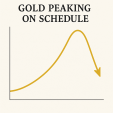Now Try Telling Me that Charts don't Work
From time to time, even these days, an article pops up by a writer who attempts to dismiss Technical Analysis, or charting, as random, worthless nonsense, or at least as being secondary to the superior art of Fundamental Analysis. One appeared on various sites not too long ago. Usually, the people writing such articles have dabbled in charting, found they had no aptitude for it, or lacked the interest and perseverance that proper study of this subject demands, and, rather than own up to the fact, they then attempt to aggrandize themselves by parading their ignorance in public attacks on the subject. Sir Isaac Newton, the legendary physicist and scientist, who had an extensive knowledge of Astrology, would silence idiots who came up to him and attempted to rubbish the subject with the simple refrain "Sir, I have studied it, you have not".
The usefulness or otherwise of charting used to be something of a theme in the London market of the 80's. I still have an old "Investor's Chronicle" from those times lying around somewhere. This was a weekly magazine for retail investors that was on sale everywhere in Britain. On the front cover is a picture of a witch doctor dancing over a stock market chart and throwing bones, with the caption "Voodoo in the Markets". It is a hilarious encapsulation of the shameful ignorance of the subject in the London market of the 80's (with the honourable exception of the Society of Technical Analysts). If I find this magazine, I'll scan it into the computer and you can all have a laugh. It's no wonder that I turned to the United States for my education in this subject, which was light years ahead of Britain with respect to the gathering and dissemination of technical market data, and with respect to the seriousness attached to Technical Analysis. Much of my grounding in this subject comes from the great Joseph Granville, whose writings and works struck a chord with me and which I avidly soaked up. His books gave me the best insights it was possible to have into market psychology, and they were easy reading, being succinct and to the point, and extremely witty, in a deadpan, black humor sort of way. These books are timeless and are just as useful and applicable in today's markets as on the day they were written, for just as there will always be divorce, rape and murder, as long as there are people on this planet, they will always be a bountiful supply of idiots in the stockmarket to sell your overpriced shares to. Note that the term "idiot" is used here loosely and not in a harshly condemnatory way - a market participant can go from being an idiot to a genius in the space of two trades - all of the greatest speculators have been idiots at some time. The writer has been an idiot too - this is a business that you learn by doing, by making your own mistakes, books help, but you have to learn it from your own experience, rather like driving or flying. I know from mails I have received that people with PhD's frequently come to the market burdened with the baggage of a superiority complex, and promptly get cut to shreds. The market has got no respect for qualifications and doesn't care if you are a doctor or a garbage collector. For some reason many highly qualified people are especially attracted to Elliot Wave theory, probably because it has a complicated, exclusive feel to it. They have written to me on several occasions, some addressing me in a patronising manner as if I'm still wet behind the ears, before going on to advise me of the exact level, to two decimal points, that the market is going to be at in 6 months time. I urge all readers who are interested in deepening their knowledge of market psychology and dynamics, and thus their ability to make money in the markets to hunt down Granville's books, although you may have to buy them secondhand and pay over-the-odds, but do it because it'll pay you handsomely. I plan to write a book in the future myself on market psychology and the predictive value of trading volume. Granville did much pioneering work with regard to the neglected subject of trading volume, and as subscribers to www.clivemaund.com know, volume studies form the bedrock of individual stock predictions, making it possible to routinely predict breakouts before they occur, and as I will shortly demonstrate unequivocally, we don't get lost in abstractions or theory on my website. We have one primary goal, to make as much money as we possibly can in the shortest possible timeframe. We aim to outflank the majority of investors, and - I know it sounds cruel - to drain their funds into our coffers. Let's face it, there's no such thing as a free lunch in this business - if you make money in stocks, it means that someone, somewhere, has had or is going to make a loss. It's tragic, I know, but that's life.
Many of you will have no doubt read the "come on" piece by that guy who tells you that the mid-east is going up in flames in about 5-years and that if you will only subscribe to his service, 500% profits on trades will be routine. This lurid article appears as an advert on some financial websites, and I believe it also gets spammed around in Emails. He substantiates his claims with examples of past trades that have netted huge profits. What he doesn't tell you is that it is actually easy to harvest some big gainers, if you start out with a nice large basket of say a thousand stock recommendations, and then quietly ditch the "also rans". On www.clivemaund.com we make no such ludicrous claims, preferring instead to keep one foot on the ground and aim for more modest but achievable returns on our investments across a broad front - 50% in 3 months here, 100% in 6 months there, that kind of thing. Not that we don't also have some spectacular successes too, such as the recent quadrupling of Silverado three weeks after it was recommended on the site. There are some losers, of course, you can't be in this game without losing from time to time, but by adhering to disciplined trading practices, losses are kept at an acceptably low level.
I also challenge the misconception harboured by some that charting is boring. Do you find the prospect of making big returns on your money boring? - I don't. Sure, charting can get tedious if you get lost in irrelevant detail as many Elliot Wavers do, but we stick to the tried and tested basics that work time and time again in combination with in-depth analysis of volume, the lifeblood of the market. Analysing price charts without reference to volume is two-dimensional, it's like examining a corpse in comparison to someone who is alive. Contrary to what you may think, it is not complicated or time-consuming to correctly analyse the volume pattern, but what is does require is long experience to do it well, and I'm afraid there are no shortcuts. We have no need to worry about the market wising up to the extent that our methods will no longer work - as Joseph Granville said "There is more maintained stupidity in this business than in probably any other business in the world". The few who do wise up eventually grow old and drop off their perches and are replaced by idiots. Charting has one supreme advantage in comparison with Fundamental analysis and that is that because you don't have to go into excruciating detail to get to the bottom of things, you have the time to look at many more opportunities. Not that good Fundamental analysis is not worthwhile - one of the stocks featured below, Polymet Mining, that we traded very well, was originally brought to my attention by a very experienced Fundamental Analyst - it's just that I'd rather somebody else does it.
That's enough introduction - now let's get to the point. There's only one thing that matters in this business, and that's results - do the methods employed make consistent and substantial returns on capital employed or not? Is the timing of entry and exit from a trade sharp, or not? Judge for yourself by looking at the following charts of stocks which were recommended on www.clivemaund.com, which are annotated with entry and exit points, and by following the links provided to the original buy and sell recommendations - I challenge anyone to question the efficacy of charting after viewing this performance. Next time anyone asks you "Does Charting work?" you'll know the answer - "That depends on who's reading them, doesn't it?"
Adanac Moly AUA.V
Buy rec. 18th September at C$0.54,
profits taken on 50% of position on 12th February at C$1.10.
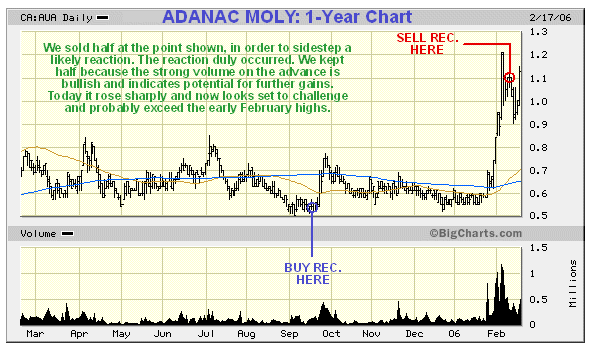
ECU Silver ECU.V
Buy rec. 11th July at C$0.25,
position still held.

Excellon Resources EXN.V
Buy rec. 5th October at C$0.19,
profits taken on at least 50% of position on 29th January at C$0.52.
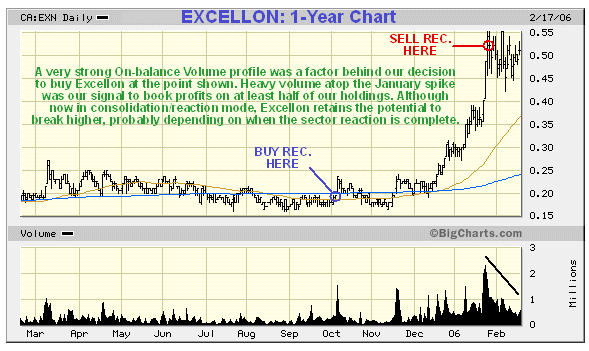
Gold Fields GFI
Buy rec. 17th November at $14.94,
profits taken on all of position on 12th February at $22.51.

Minefinders MFN
Buy rec. 9th September at C$3.85,
profits taken on all of position on 8th February at $6.93.
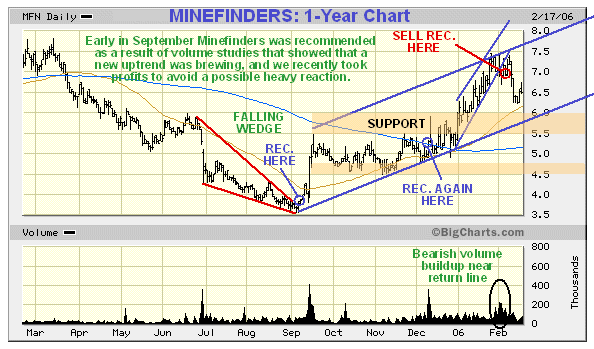
Northgate Minerals NXG
Buy rec. 17th November at $1.36,
profits taken on part of position on 17th January at C$2.12.

Polymet Mining POM.V
Buy rec. 15th August at C$1.00,
and subsequently traded at intermediate turning points.
Position liquidated completely at C$2.65 on 28th January.
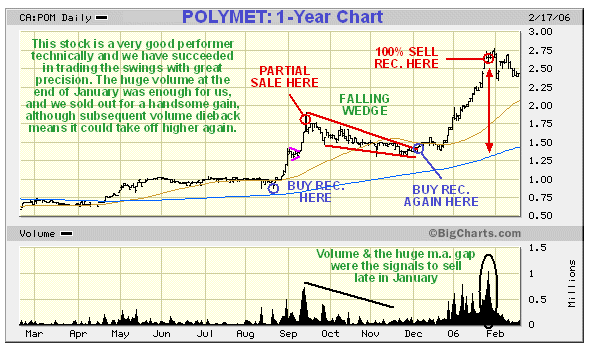
Revett Minerals RVM.TO
Buy rec. 23th November at C$0.62,
profits taken on all of position on 27th January at C$1.25.
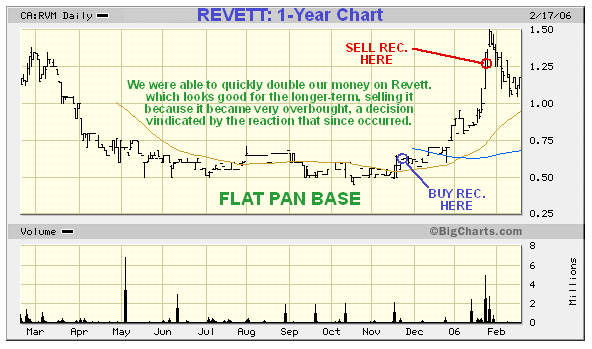
Rio Tinto RTP
Buy rec. 27th June at $123.33,
profits taken on all of position on 18th January at $197.84.
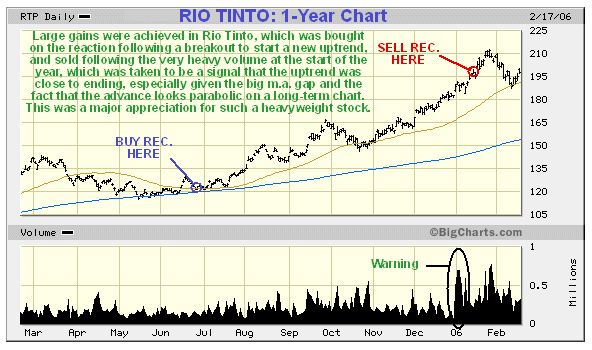
Silver Wheaton SVM
Buy rec. 12th July at $3.24,
profits taken on part of position on 2nd February at $8.00.

Silverado Gold Mines SLGLF
Buy rec. 11th January at $0.054,
profits taken on 50% of position on 7th February at $0.22.

Charts used are for the close of trading on Friday 17th February 06
The market is bigger and infinitely more powerful than any individual - it is like some giant untamed beast that is going to do what it's going to do whatever anyone thinks about it. We make money by harmonizing with its movements, for the market is not going to make any concessions to suit our convenience, and doesn't care if we get wiped out. This cannot be achieved all the time and we accept this. At times the market, and individual stocks, react to exogenous events (bolt out of the blue unexpected developments) that cannot reasonably be predicted, an example being Hugo Chavez of Venezuela suddenly saying he would nationalize all the mines in his country, which caused stocks like Crystallex to crater about a year ago. Thus, although we aspire to be right as much as is humanly possible, we do not expect to be right all the time - such an expectation is the mark of a fool. What matters is not being wrong, but how you handle being wrong, how you handle being in a losing situation, for this, perhaps more than anything else determines whether you will ultimately come out on top in this game. When it is clear that an error has been made - a simple example being when you buy a stock which contacts the lower line of a trend channel, in the reasonable expectation that it will go up again, and instead it breaks down from the channel - it is crucial to acknowledge the error as early as possible, and then to take whatever action the situation demands at the appropriate time, and if this means taking a loss to avoid a probable larger loss later on, so be it. Afterwards, you do not beat yourself up about it, you review the episode, learn whatever you can from it, and move on. Mistakes, particularly when you are a newcomer to the market are a fundamental part of the learning process, and actually lay the foundation for future success, and although mistakes diminish with time and experience, there will never be a time when you are entirely free from them. If such a time arrived, you would end up becoming complacent - and make mistakes. So, we aspire to be right all of the time, expect to be right significantly more often than we are wrong, and when wrong, quickly implement damage limitation measures. Thus we end up making money, and use the mistakes to hone our trading skills still further.
Clive Maund, Diploma Technical Analysis
Kaufbeuren, Germany, 18 February 2006









